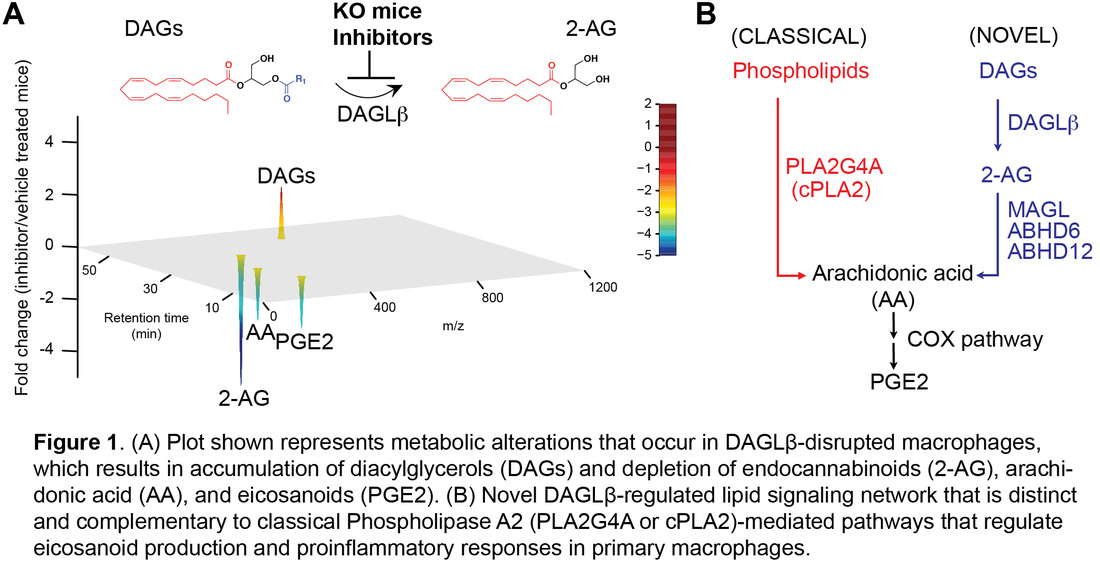The Hsu laboratory seeks to develop and apply chemical tools to functionally interrogate lipid-signaling pathways in mammalian immunology. For example, we developed the first potent, selective, and in vivo-active small-molecule inhibitors along with specialized chemoproteomic biochemical assays for an important set of serine hydrolases, diacylglycerol lipases-alpha and beta (DAGLα and DAGLβ) that are involved in the biosynthesis of the endocannabinoid, 2-arachidonoylglycerol (2-AG, Figure 1A). Endocannabinoids are bioactive lipids that activate the G-protein coupled receptors CB1 and CB2, which also recognize the principal psychoactive component of marijuana Δ9-tetrahydrocannabinol (THC). Cannabinoid signaling controls a diverse array of behavioral processes including pain, emotionality, inflammation, addiction, and metabolism.
We utilized our DAGL-selective inhibitors and specialized activity-based probes in conjunction with quantitative metabolomics and genetic knockout (KO)-mice to characterize the metabolic and cell biological functions of DAGLβ in primary macrophages. Several important discoveries emerged from our systems-based studies. First, we found that DAGLβ was the principal 2-AG biosynthetic enzyme in primary macrophages and its inactivation resulted in alterations in cellular levels of several bioactive lipids (Figure 1A). We found that accumulation of DAG substrates was observed in inhibitor treated- but not KO-mice, highlighting the importance of complementing traditional genetic disruption models with pharmacological studies to account for compensatory mechanisms that can occur during development. Second, we discovered a novel DAGLβ-regulated lipid network that regulates proinflammatory responses in macrophages. Specifically, our discovery that DAGLβ coordinately regulates endocannabinoid and eicosanoid production in macrophages in a manner that is distinct and complementary to the classical phospholipase A2-mediated pathway points to a new paradigm whereby significant cross-talk exists between these lipid signaling networks to fine-tune the proinflammatory response in macrophages (Figure 1B). Finally, our studies showed that DAGLβ-inactivation reduced lipopolysaccharide (LPS)-stimulated production of TNF-α, pointing to the disruption of this enzyme and its endocannabinoid/eicosanoid network as a potentially novel therapy for inflammatory disorders.
Future studies are directed towards further exploring the cross-talk between DAGLβ- and cPLA2-mediated pathways under different inflammatory states, post-translational regulation of DAGL activity, and role of DAGL-regulated pathways in inflammatory disorders.
Representative publications
1. K.L. Hsu et al., DAGLbeta inhibition perturbs a lipid network involved in macrophage inflammatory responses. Nat Chem Biol 8, 999 (2012).
2. K.L. Hsu et al., Development and optimization of piperidyl-1,2,3-triazole ureas as selective chemical probes of endocannabinoid biosynthesis. J Med Chem 56, 8257 (2013).
Future studies are directed towards further exploring the cross-talk between DAGLβ- and cPLA2-mediated pathways under different inflammatory states, post-translational regulation of DAGL activity, and role of DAGL-regulated pathways in inflammatory disorders.
Representative publications
1. K.L. Hsu et al., DAGLbeta inhibition perturbs a lipid network involved in macrophage inflammatory responses. Nat Chem Biol 8, 999 (2012).
2. K.L. Hsu et al., Development and optimization of piperidyl-1,2,3-triazole ureas as selective chemical probes of endocannabinoid biosynthesis. J Med Chem 56, 8257 (2013).
